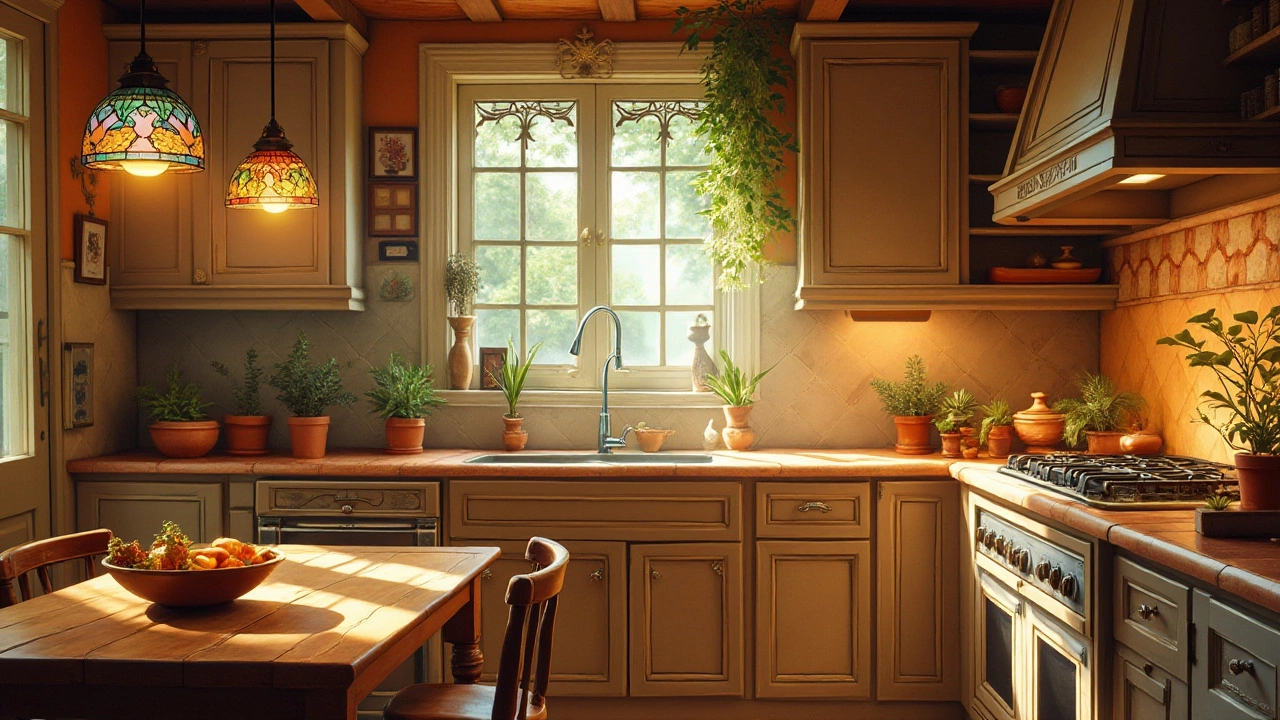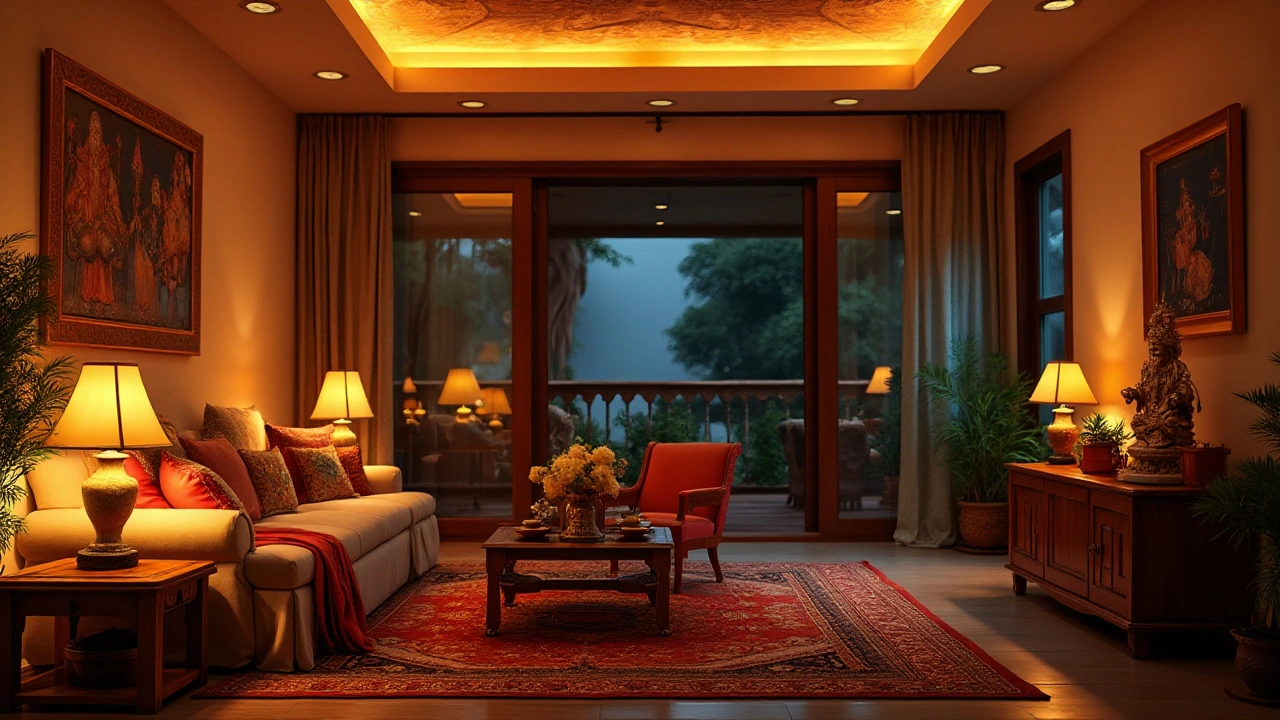Lighting isn't just about illumination—it's about capturing the essence of a room, enhancing its function and mood. With endless lighting options available, knowing where to start can feel overwhelming. But fear not, as selecting the right lighting can be as transformative as a fresh coat of paint. From invoking calm in a bedroom with soft, warm lights to igniting energy in a home office with bright, cool illuminations, each space in your home has its unique lighting needs. Ready to shed some light on the subject and illuminate your home's full potential? Let's delve into the world of lighting possibilities.
- Understanding Color Temperature
- The Role of Natural Light
- Task Lighting vs. Ambient Lighting
- Innovative Smart Lighting Solutions
- Art and Accent Lighting
- Layering Lighting for Atmosphere
Understanding Color Temperature
When it comes to home lighting, understanding color temperature is like discovering the secret ingredient in a beloved recipe. It changes everything. Color temperature refers to the hue of a light source and is measured in Kelvin (K). The lower the Kelvin number, the warmer and more yellow the light appears. Conversely, higher Kelvin numbers result in cooler, bluer hues.
Warm vs. Cool Lighting
Warm lighting, which typically ranges from 2000K to 3500K, evokes a feeling of coziness and intimacy. It's perfect for rooms where relaxation is key, like living rooms and bedrooms. In contrast, cool lighting, with temperatures above 5000K, is invigorating and ideal for task-oriented spaces like kitchens and offices. The stark difference is more than just visual; it affects how we feel within the space.
The Science Behind Color Temperature
Ever noticed how natural sunlight changes throughout the day? This isn’t coincidental. According to a study by the Lighting Research Center, exposure to different light temperatures can influence circadian rhythms and overall well-being. It’s essential to align your home’s lighting with your daily activities for optimal comfort.
"The contrasts in lighting can greatly influence not just the aesthetics of a space but also the psychological responses of its occupants," says Dr. Anna Esposito, a renowned lighting designer.
By choosing the appropriate lighting, you're not just improving visibility but enhancing the very atmosphere of your home. Select a color temperature that matches the intended mood of your space, and watch as your home subtly transforms.
Practical Applications by Room
- Living Rooms: Opt for warm lighting to create a calming environment for relaxation and social gatherings.
- Kitchens: Cool lighting can help with precision in cooking and food preparation.
- Offices: Aim for daylight-mimicking lights to improve focus and productivity.
- Bathrooms: A mix of warm and cool lights can help create a functional yet comforting space.
Whether you’re reading beneath the soft glow of a bedside lamp or chopping vegetables under bright kitchen lights, understanding color temperature enables you to make informed choices that enhance both the aesthetics and functionality of your interiors.
The Role of Natural Light
In the realm of home lighting, natural light stands as an irreplaceable component. The sun’s illumination is not just efficient—it’s essential for our well-being. Studies have revealed that exposure to natural light can significantly improve mood, regulate sleep patterns, and increase productivity. But harnessing natural light requires more than just flinging open the curtains.
Maximizing the effect of natural light in your home involves strategic design and thoughtful consideration. Factors like the placement of windows, the direction your home faces, and even your selection of window treatments can influence how natural light enters and enhances a space. For instance, larger south-facing windows are perfect for capturing the winter sun's warmth, yet they might need shading solutions to counter the summer heat.
Designing for Nature's Light
Architects and interior designers often emphasize the importance of natural lighting in home plans. “Natural light has the incredible ability to make any space feel larger and more inviting,” says renowned architect John Alison, adding, “It’s about creating a connection with the outdoors that technology just cannot replicate.”
“Design is not just what it looks like and feels like. Design is how it works.” — Steve Jobs
When designing or remodeling a space, consider not only windows but also reflective surfaces that can magnify natural light. Mirrors, glass tables, or light-colored walls can reflect sunlight and help it travel further into your home.
Enhancing with Artificial Aid
Sometimes, natural light isn’t abundant. In areas or seasons lacking in natural daylight, integrating artificial lighting that mimics daylight can be beneficial. Bulbs rated at 6000K approximate daylight, providing a similar spectrum of light that supports mood and clarity.
- Use sheer curtains to allow sunlight while maintaining privacy.
- Opt for light or neutral-colored walls to amplify the brightness.
- Incorporate glass doors within the home to share light between rooms.
- Utilize reflective surfaces to spread the daylight further.
| Direction | Best Use |
|---|---|
| North-facing | Ideal for kitchens, capturing even, consistent light |
| South-facing | Maximize in living rooms to enjoy warmth and brightness |
Harnessing natural lighting is about understanding and working with the rhythm of the day, making conscious design choices, and sometimes, creatively supplementing with artificial solutions. Your home should not only be a sanctuary but also a space that invigorates you naturally.
Task Lighting vs. Ambient Lighting
Lighting can be more nuanced than flipping a switch. Two fundamental types of lighting are crucial to mastering the art of illumination in your home: task lighting and ambient lighting. While these two serve different purposes, they work in tandem to create a perfectly lit environment.
Understanding Ambient Lighting
Often called general lighting, ambient lighting provides an overall illumination to a space. It’s what you envision when thinking of overhead lights that fill a room with light. The primary goal of ambient lighting is to ensure uniform light levels, allowing easy navigation and a broader sense of space. Pendant lights, chandeliers, ceiling-mounted fixtures, and wall sconces are common choices for achieving effective ambient lighting.
An interesting fact is that in bedrooms, ambient lighting should offer a cozy atmosphere. According to lighting experts, a color temperature between 2700K to 3000K is both warm and relaxing, making it perfect for winding down at night.
Focusing on Task Lighting
Specificity is the hallmark of task lighting. It’s dedicated to helping you perform specific activities such as reading, cooking, or working on a hobby. Task lighting should be more intense than ambient lighting, as it focuses on particular areas where concentrated light is needed. Desk lamps, under-cabinet lights, and track lighting are some robust options in this category.
How to Choose Task Lighting
- Adjustability: Choose fixtures that can be directed or adjusted, allowing light to hit just the right spot.
- Shielding: Adequate shielding or bases that focus light help reduce glare, ensuring comfort for the eyes.
- Intensity: Variable intensity settings or dimmable features provide control over the amount of light, adapting it to different times of day and tasks.
In kitchens, for example, task lighting under cabinets can defeat shadows on work surfaces, transforming culinary chores into delightful experiences.
| Lighting Type | Purpose | Common Fixtures |
|---|---|---|
| Ambient Lighting | Overall illumination | Chandeliers, ceiling fixtures |
| Task Lighting | Focused work tasks | Desk lamps, under-cabinet lights |
In conclusion, the strategic use of both task and ambient lighting is crucial for creating a balanced, functional home. By understanding and implementing these types of lighting, you can enhance both the utility and aesthetics of your space, making it more inviting and enjoyable to live in.

Innovative Smart Lighting Solutions
Gone are the days when flicking a switch was the only way to control the lighting in your home. Today, innovative smart lighting solutions are reimagining how we illuminate our living spaces, offering convenience, energy efficiency, and a touch of modern magic. But what exactly do these technologies bring to the table, and how can you make them work for you?
The Rise of Smart Bulbs
At the forefront of this revolution are smart bulbs, which integrate with home automation systems to offer customizable and wireless lighting control. Brands like Philips Hue and LIFX have made it incredibly easy to adjust the intensity, color, and timing of your lights right from your smartphone or through voice commands using virtual assistants like Alexa, Google Assistant, or Siri. Whether you're at home or on vacation, you can ensure your house is never left in the dark.
Features and Benefits
Smart lighting isn't just about convenience; it offers myriad benefits. For instance, these systems can significantly reduce energy consumption. By utilizing presence sensors, lights automatically turn off when a room is empty, saving both energy and money. With custom schedules, your lighting can simulate occupancy even when you're not home, adding a layer of security.
Entertainment Syncing
For the tech-savvy, smart lighting can take home entertainment to a new level. Systems can sync with your TV or music, changing colors and brightness to enhance movie nights or parties. This dynamic lighting setup provides an immersive experience, whether you're diving into a new film or hosting friends.
Considerations Before You Dive In
While the perks are compelling, integrating smart lighting requires some considerations. First, compatibility with existing devices or ecosystems is crucial. Be sure to choose products that integrate seamlessly into your home network and play nicely with other smart devices.
Another factor is connectivity. A stable Wi-Fi connection ensures smooth operation and control across all zones. It may be wise to assess your network capabilities and perhaps even upgrade your router or employ range extenders to maintain a robust connection.
| Average Energy Savings with Smart Lighting | |
|---|---|
| Scenario | Savings |
| Typical Household Use | 20-30% |
| Optimized Schedule | Up to 50% |
| Presence Detection | 40-60% |
Embracing smart lighting can transform your home into an energy-efficient, fully personalized haven. As technology continues to evolve, the possibilities for customization and control will only expand. Whether you're starting small with a bulb or two or going all out with a full home integration, there's no doubt that smart lighting is illuminating the future of indoor environments.
Art and Accent Lighting
When it comes to showcasing your home's interior beauty, nothing works quite like art and accent lighting. These specialized lighting techniques do more than just illuminate—they highlight the architectural features, add depth, and bring cherished objects into the limelight, turning your home into a curated gallery where every piece speaks volumes.
Understanding Accent Lighting
Accent lighting draws attention to particular focal points within a room, such as artwork, sculptures, or textured walls. It is typically used at a higher intensity than the ambient light to ensure that these features stand out. Think about how a museum uses spotlights to make exhibits pop; that's accent lighting at work. The key here is directionality—focused beams are your best friends.
Types of Accent Lighting Fixtures
- Downlights: Perfect for directing light onto artwork or mantlepieces. Their adjustable heads allow for precise light aiming, making them essential for art collections.
- Wall-mounted fixtures: These fixtures double up as decorative elements themselves while emphasizing specific areas like corridors, stairwells, or textured walls.
- Track lights: A versatile choice for accent lighting, track lights consist of multiple lights on a single track. They can be directed individually for customized lighting arrangements.
Art Lighting—A Masterstroke
Lighting artwork is an art in itself, requiring the right combination of color temperature, intensity, and angle. The aim is to enhance, never overwhelm, the colors and intricacies of the piece. LED lights have become a popular choice due to their ability to emit steady, pure light without heat, preventing damage to delicate pieces.
Key Considerations for Art Lighting
- Color Temperature: Opt for bulbs with a color temperature rating between 2000K and 3000K. This range mimics the warm, natural tones found in galleries.
- Angle and Distance: Position lights at a 30-degree angle from the artwork to minimize glare and shadow.
Done right, art and accent lighting will not only enhance the aesthetics of your home but will also offer a new perspective on spaces you thought you knew, inviting conversation and admiration from all who visit.
Layering Lighting for Atmosphere
Creating the right home lighting is much like crafting an artwork, where each layer contributes a unique element to the whole. By skillfully combining various lighting types, you can transform any room into a visually captivating space. This method, known as layering lighting, involves the strategic use of ambient, task, and accent lighting to sculpt the environment according to your needs and tastes.
Creating a Base with Ambient Lighting
Ambient lighting acts as the canvas for your interior masterpiece. It provides essential general illumination for everyday activities. Often, an overhead fixture like a chandelier or flush-mount ceiling light serves this purpose. According to the Illuminating Engineering Society, "Ambient lighting is the basic, foundational layer of lighting." This principle illuminates the importance of ambient lighting in setting the stage for a comfortable environment.
Adding Precision with Task Lighting
Task lighting provides focus where you need it most, whether it’s under-cabinet lights in a kitchen to enhance cooking visibility, or a desk lamp aiding late-night work sessions. The key here is to blend functionality with style. For areas that require precision, consider adjustable lamps or directed lighting fixtures that illuminate specific tasks while reducing glare.
Highlighting Details with Accent Lighting
Accent lighting is your chance to add drama and bring attention to specific features within a room. Think artwork, architectural elements, or even a beloved houseplant. Spotlights, track lights, or wall sconces can all serve as accent lighting. They should be at least three times as bright as the rest of the lighting in the room to create that perfect contrast.
Integrating Smart Lighting Options
With the rise of technology, incorporating smart lighting has become an attractive option. Smart lighting systems allow remote control of light intensity and color, adapting lighting to suit different times of day or moods, providing an added layer of convenience and customization.
"Lighting is a powerful tool in creating a mood and defining the character of a space, by the way a texture or color of a surface appears under light." - Jason Nickel, Lighting Designer
The beauty of layered lighting is in its flexibility. By experimenting with combinations, you can achieve the right balance and transform the ordinary into the extraordinary. Whether it’s drawing out the warmth in a living room or amplifying the elegance of a dining area, a well-considered lighting design can make all the difference in your home’s ambience.

